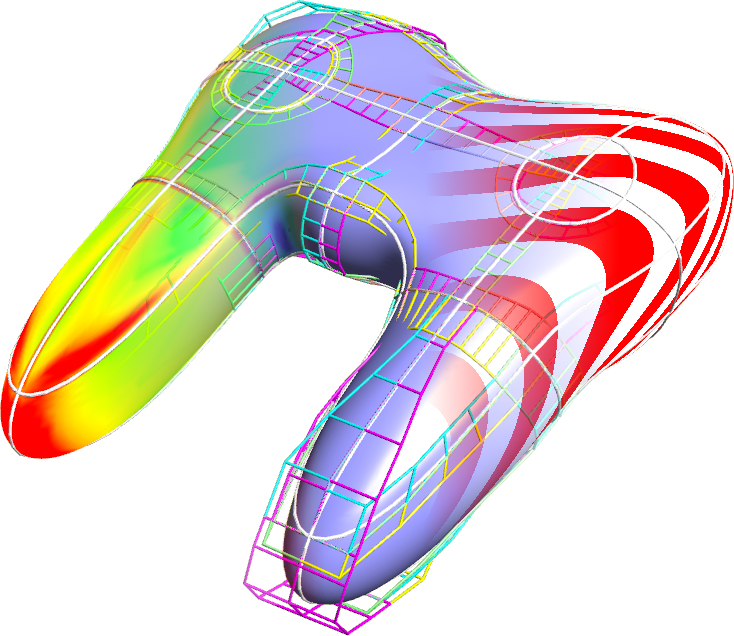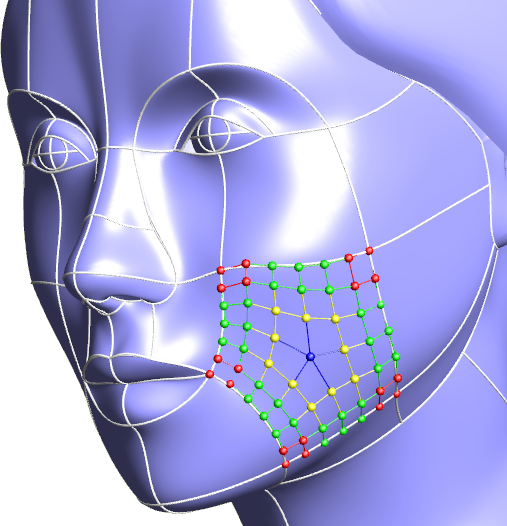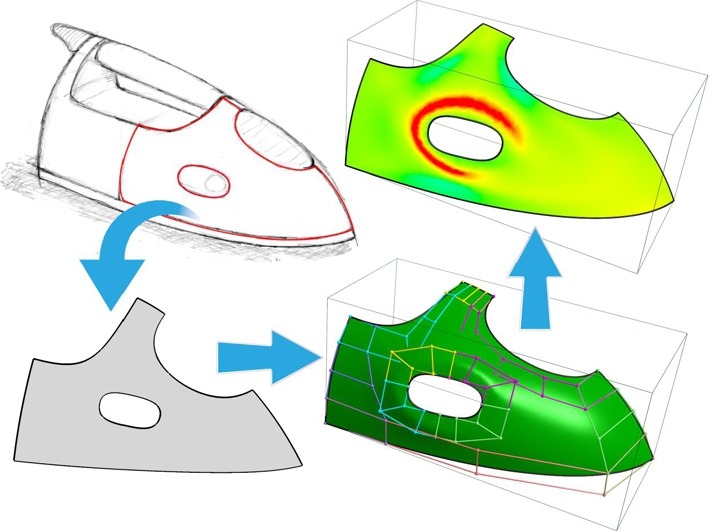Multi-sided surfaces
[edit]We have developed several surface representations over the years, both transfinite interpolation surfaces and control point based patches, but the classification is not clear-cut, as some surfaces have properties of both groups.
Transfinite interpolation surfaces
Transfinite surfaces with interior control
Survey
We have written a survey on genuine multi-sided surfaces which should be the starting point for getting to know this topic:
T. Várady, P. Salvi, M. Vaitkus, Genuine multi-sided parametric surface patches - A survey. Computer Aided Geometric Design, Vol. 110, #102286, 2024. DOI • BibTeX
Control point based surfaces
Modifying a control point based surface while maintaining continuity with adjacent surfaces is hardly feasible manually. In the following paper we propose a workflow for implicit modification of the control points through control vectors. Initial scaling of cross-derivatives is also discussed.
P. Salvi, M. Vaitkus, T. Várady, Constrained modeling of multi-sided patches. Computers and Graphics, Vol. 114, pp. 86-95, 2023. DOI • BibTeX
For complex patches creating a unified control structure can be tricky. We generate it from distance parameter based medial axis:
M. Vaitkus, P. Salvi, T. Várady, Interior control structure for Generalized Bézier patches over curved domains. Computers and Graphics, Vol. 121, #103952, 2024. DOI • BibTeX
A generalization enables the use of B-spline boundaries and multiply connected patches; other features include approximative and exact ribbon interpolation and a new system of blending functions associated with the template geometry:
M. Vaitkus, P. Salvi, T. Várady, A general framework for adding interior control to ribbon-based multi-sided surfaces. Computers and Graphics, Vol. 131, #104322, 2025. DOI • BibTeX
Generalized Bézier/B-spline surface
Generalized Bézier patches are multi-sided surfaces that can interpolate polynomial boundary curves and connect to adjacent patches with arbitrary geometric continuity. The associated control structure is simple and intuitive, with an algorithm for default placement based solely on boundary constraints. Additional interior control is possible via degree elevation.
T. Várady, P. Salvi, Gy. Karikó, A Multi-sided Bézier patch with a simple control structure. Computer Graphics Forum, Vol. 35(2), pp. 307-317, 2016. DOI • BibTeX
- The original paper - this is where you should start.
T. Várady, P. Salvi, I. Kovács, Enhancement of a multi-sided Bézier surface representation. Computer Aided Geometric Design, Vol. 55, pp. 69-83, 2017. DOI • BibTeX
- Better handling of the central control point.
- Simpler rational weights.
- Alternative parameterization.
- Various surface algorithms.
P. Salvi, T. Várady, Multi-sided Bézier surfaces over concave polygonal domains. Computers & Graphics, Vol. 74, pp. 56-65, 2018. DOI • BibTeX
- Generalization to concave domains using harmonic coordinates.
T. Várady, P. Salvi, M. Vaitkus, Á. Sipos, Multi-sided Bézier surfaces over curved, multi-connected domains. Computer Aided Geometric Design, Vol. 78, #101828, 2020. DOI • BibTeX
- Generalization to curved domains.
M. Vaitkus, T. Várady, P. Salvi, Á. Sipos, Multi-sided B-spline surfaces over curved, multi-connected domains. Computer Aided Geometric Design, Vol. 89, #102019, 2021. DOI • BibTeX
- Further generalization to B-spline boundaries.
- Better parameterization.
M. Vaitkus, T. Várady, P. Salvi, Generalized B-spline surfaces over curved domains. Proceedings of the Tenth Hungarian Conference on Computer Graphics and Geometry, pp. 36-43, 2022. Full paper • BibTeX
- Conference version
P. Salvi, Polyhedral design with blended n-sided interpolants. Proceedings of the Eleventh Hungarian Conference on Computer Graphics and Geometry, pp. 46-51, 2024. Full paper • BibTeX
- Smooth parametric surface interpolating the vertices of a mesh of arbitrary topology
- Similar to the manifold construction of Ying and Zorin
- Uses quadratic(!) GB surfaces and a nice parameterization based on conic sections
T. Várady, P. Salvi, M. Vaitkus, Generalized Bézier and B-spline patches with exact refinement. Proceedings of the Eleventh Hungarian Conference on Computer Graphics and Geometry, pp. 58-62, 2024. Full paper • BibTeX
- Degree elevation (Bézier) and knot insertion (B-spline) of the ribbons in a way that retains the original surface
- The weight deficiency of the base patch is also retained, with beneficial effect
P. Salvi, T. Várady, Multi-sided surfaces with fullness control. Proceedings of the Eighth Hungarian Conference on Computer Graphics and Geometry, pp. 61-69, 2016. Full paper • BibTeX
- Comparison to Midpoint patches (see below), as both representations can be used as transfinite interpolation surfaces with interior control.
P. Salvi, T. Várady, K.T. Miura, Approximating point clouds by generalized Bézier surfaces. Proceedings of the Workshop on the Advances of Information Technology, pp. 61-66, 2018. Full paper • BibTeX
- Notes on fitting with GB patches
J. Szörfi, T. Várady, Polyhedral design with concave and multi-connected faces. Proceedings of the Tenth Hungarian Conference on Computer Graphics and Geometry, pp. 28-35, 2022. Full paper • BibTeX
- Application of GB patches for polyhedral design
S-patch
S-patches (by Loop & DeRose) represent a logical generalization of Bézier triangles to an arbitrary number of sides. They have many nice properties, but due to the large number of control points, S-patches are hard to use for shape design. The papers below explain some useful S-patch-based constructions in detail.
P. Salvi, G1 hole filling with S-patches made easy. Proceedings of the 12th Conference of the Hungarian Association for Image Processing and Pattern Recognition, #1, 2019. Full paper • arXiv • BibTeX
- Interpolating an n-sided Sabin net with an S-patch.
- All the required equations for interpolating the boundary constraints are explicitly stated.
- Interior control points are computed by a linear system of equations using biharmonic masks.
- See also the poster.
P. Salvi, On the CAD-compatible conversion of S-patches. Proceedings of the Workshop on the Advances of Information Technology, pp. 72-76, 2019. Full paper • arXiv • BibTeX
- Summarizes the process of converting an S-patch to a tensor product rational Bézier surface.
- All required equations are explicitly stated.
- Actual examples are shown.
Zheng-Ball patch
The Sabin / Hosaka-Kimura / Zheng-Ball patches use a very interesting, implicitly defined parameteterization, but it is not trivial how to tessellate the resulting surfaces. The following paper sheds some light on this.
P. Salvi, P. Gál, Tessellation of Zheng-Ball patches. Proceedings of the Workshop on the Advances of Information Technology, pp. 35-39, 2023. Full paper • BibTeX
Transfinite interpolation surfaces
Generalized Coons patch
This surface representation generalizes the Coons patch for any number of sides. The basic idea is to decompose the Boolean sum formula on a per-side basis, and then generalization is straightforward. There are derivative constraints for the local parameter mappings; various methods for this are explored.
T. Várady, A. Rockwood, P. Salvi, Transfinite surface interpolation over irregular n-sided domains. Computer Aided Design, Vol. 43(11), pp. 1330-1340, 2011. DOI • BibTeX
- Review of prior art (including the Charrot-Gregory patch and Kato's patch).
- Non-regular domain construction.
- Overlap parameterization.
P. Salvi, T. Várady, A. Rockwood, Ribbon-based transfinite surfaces. Computer Aided Geometric Design, Vol. 31(9), pp. 613-630, 2014. DOI • BibTeX
- Parameterizations are explained in detail.
- Two new mappings: interconnected and cubic.
- Comparison to composite ribbon patches (see below), Charrot-Gregory patches and Kato's patch.
P. Salvi, T. Várady, A. Rockwood, New schemes for multi-sided transfinite surface interpolation. Proceedings of the Sixth Hungarian Conference on Computer Graphics and Geometry, pp. 56-63, 2012. Full paper • BibTeX
- Same as above (conference version).
P. Salvi, T. Várady, A. Rockwood, Transfinite surface interpolation over specific curvenet configurations. Proceedings of the 14th IMA Conference on Mathematics of Surfaces, pp. 309-326, 2013. Full paper • BibTeX
- Curvature continuity using parabolic ribbons.
- Defining connection curves to split concave regions.
P. Salvi, T. Várady, Comparison of two n-patch representations in curve network-based design. Proceedings of the 10th Conference of the Hungarian Association for Image Processing and Pattern Recognition, pp. 612-624, 2015. Full paper • BibTeX
- Detailed comparison to Charrot-Gregory patches (see below).
- See also the poster.
Composite Ribbon patch
These surfaces are created as a blended sum of "composite ribbons", each one interpolating three consecutive boundaries. Because of this construction, there is no need for constrained parameterizations, and simpler ones can be applied. Also, the stronger, less local relationship between the ribbons and the boundary constraints ensures better surface quality.
T. Várady, P. Salvi, A. Rockwood, Transfinite surface patches using curved ribbons. EuroGraphics 2013 - Short Papers, pp. 5-8, 2013. DOI • BibTeX
- Short paper version, showing only the essentials of the CR patch - a good place to start.
P. Salvi, T. Várady, A. Rockwood, Ribbon-based transfinite surfaces. Computer Aided Geometric Design, Vol. 31(9), pp. 613-630, 2014. DOI • BibTeX
- The original paper.
- Comparison to generalized Coons patches (see above), Charrot-Gregory patches and Kato's patch.
P. Salvi, T. Várady, A. Rockwood, New schemes for multi-sided transfinite surface interpolation. Proceedings of the Sixth Hungarian Conference on Computer Graphics and Geometry, pp. 56-63, 2012. Full paper • BibTeX
- Conference version of the original paper.
T. Várady, P. Salvi, New multi-sided patches for curve network-based design. Proceedings of the 9th Conference of the Hungarian Association for Image Processing and Pattern Recognition, pp. 566-579, 2013. Full paper • BibTeX
- Another conference version.
P. Salvi, A multi-sided generalization of the C0 Coons patch. Proceedings of the Workshop on the Advances of Information Technology, pp. 110-111, 2020. Full paper • arXiv • BibTeX
- The same idea, but without cross-derivative constraints.
- A very lightweight multi-sided patch (and a short read!).
Charrot-Gregory patch
The Charrot-Gregory patch may be the closest to a de facto standard for multi-sided surfaces. It is defined as a blended sum of corner ribbons (interpolating two adjacent sides). Compare also the Composite Ribbon patch (above), and the Midpoint patch (below).
P. Salvi, T. Várady, G2 surface interpolation over general topology curve networks. Computer Graphics Forum, Vol. 33(7), pp. 151-160, 2014. DOI • BibTeX
- Extension to curvature continuity.
P. Salvi, T. Várady, Multi-sided Surfaces with Curvature Continuity. Proceedings of the Seventh Hungarian Conference on Computer Graphics and Geometry, pp. 13-20, 2014. Full paper • BibTeX
- Another, somewhat longer version of the above.
P. Salvi, T. Várady, Comparison of two n-patch representations in curve network-based design. Proceedings of the 10th Conference of the Hungarian Association for Image Processing and Pattern Recognition, pp. 612-624, 2015. Full paper • BibTeX
- Detailed comparison to generalized Coons patches (see above).
- See also the poster.
Optimization
It is not trivial how to set correct ribbon widths (see also our papers on control vectors). One possibility is to use these as variables for minimizing some kind of fairness energy:
E. Günpınar, A. A. Taşmektepligil, M. Vaitkus, P. Salvi, Optimization of cross-derivatives for ribbon-based multi-sided surfaces. Graphical Models, Vol. 140, #101275, 2025. DOI • BibTeX
- Different energies for different kinds of models
E. Günpınar, A. A. Taşmektepligil, M. Vaitkus, P. Salvi, Transfinite surfaces with optimized ribbon cross-derivatives and surfaces over concave domains. Proceedings of the CAD Conference, pp. 205-209, 2024. DOI • BibTeX
- Short paper version
Transfinite surfaces with interior control
Kato's patch
Kato's patch is a unique multi-sided surface that is able to smoothly interpolate concave patches with holes, using singular blending functions. Compare also our work on GB patches over concave and curved domains (above).
T. Várady, P. Salvi, A. Rockwood, Transfinite surface interpolation with interior control. Graphical Models, Vol. 74(6), pp. 311-320, 2012. DOI • BibTeX
- Controlling the interior using auxiliary points and curves.
- Blending interior surfaces.
- One- and two-sided patches.
T. Várady, P. Salvi, A. Rockwood, 3D shape design using curve networks with ribbons. Proceedings of the Sixth Hungarian Conference on Computer Graphics and Geometry, pp. 34-41, 2012. Full paper • BibTeX
- Same as above (conference version).
Midpoint patch
Midpoint patches, like Charrot-Gregory patches, combine corner ribbons, but with a "weight-deficient" blending function that provides an extra degree of freedom to set the fullness of the patch. Although not widely known, this is one of our best patches in terms of surface quality.
P. Salvi, T. Várady, Multi-sided surfaces with fullness control. Proceedings of the Eighth Hungarian Conference on Computer Graphics and Geometry, pp. 61-69, 2016. Full paper • BibTeX
- The original paper.
- Comparison to GB patches (above).
P. Salvi, I. Kovács, T. Várady, Computationally efficient transfinite patches with fullness control. Proceedings of the Workshop on the Advances of Information Technology, pp. 96-100, 2017. Full paper • arXiv • BibTeX
- Side-based variation: the Midpoint Coons patch is the same to the Midpoint patch as the generalized Coons patch is to the Charrot-Gregory patch.
Displacement blends
The interior of any transfinite surface - irrespective of its representation - can be edited using displacement vectors multiplied by suitable blending functions.
P. Salvi, Editing the interior of arbitrary surfaces using C-infinity displacement blends. Proceedings of the Workshop on the Advances of Information Technology, pp. 35-38, 2021. Full paper • BibTeX
CAD-compatible conversion
Commercial CAD applications generally do not support multi-sided patches, only trimmed NURBS surfaces. Exporting native n-patches is normally done by approximation, but when the boundaries are polynomial curves, often the whole patch can be written as a rational polynomial surface, and can be converted to Bézier form exactly, without compromising continuous connections, interior quality, or ease of shape editing.
The following papers show how different multi-sided representations can be converted, and the quality of the generated control networks is also examined.
P. Salvi, T. Várady, A. Rockwood, Notes on the CAD-compatible conversion of multi-sided surfaces. Computer-Aided Design and Applications, Vol. 18(1), pp. 156-169, 2021. DOI • BibTeX
P. Salvi, T. Várady, A. Rockwood, Notes on the CAD-compatible conversion of multi-sided surfaces. Proceedings of the CAD Conference, pp. 11-15, 2020. DOI • BibTeX
- Short paper version
Miscellaneous
A hybrid patch formulation combining the intuitive control of GB patches with the arbitrary boundaries of tranfinite interpolation surfaces.
P. Salvi, Intuitive interior control for multi-sided patches with arbitrary boundaries. Computer-Aided Design and Applications, Vol. 21(1), pp. 143-154, 2024. DOI • BibTeX
P. Salvi, Intuitive interior control for multi-sided patches with arbitrary boundaries. Proceedings of the CAD Conference, pp. 26-30, 2023. DOI • BibTeX
- Short paper version
The following paper is the result of an interesting experiment - using a circle as the domain for multi-sided patches. It is particularly suited for periodic boundaries.
P. Salvi, A circular parameterization for multi-sided patches. Proceedings of the Tenth Hungarian Conference on Computer Graphics and Geometry, pp. 22-26, 2022. Full paper • arXiv • BibTeX





